5
The Triple Goddess of Stone
JUST AS THE GREAT GODDESS IS SEEN in the three different guises that follow the human life cycle, she also appears in the three phases of the rock cycle. The rock cycle is a model used in geology to describe the genesis and transitions of the three categories of rocks: igneous, sedimentary, and metamorphic. Igneous rocks are those born of cooling magma or lava. Sedimentary rocks are made of the weathered remains of other rocks cemented together. Metamorphic rocks are created when extant igneous and sedimentary rocks are exposed to heat and pressure, causing their constituent minerals to transform.
The rock cycle as illustrated on the facing page is not a linear progression from one phase to the next. Accordingly, there is no definitive, black-and-white correlation between the three categories of rocks and the faces of the Triple Goddess. Although it is possible to find aspects of each of the Goddess’s faces in any of the phases of the rock cycle, my own personal experience has led me to generally correlate the Maiden with igneous rocks, the Mother with metamorphic rocks, and the Crone with sedimentary rocks.
The three faces of the Goddess as reflected in the mineral kingdom do not come from myth or traditional lore; rather, they are the result of my listening to the whispers of the Goddess of Stone and my own personal gnosis. Although these Goddess forms may not be ancient, the stones from which they draw their symbolism have always been part of Earth (and therefore part of the Great Goddess herself).
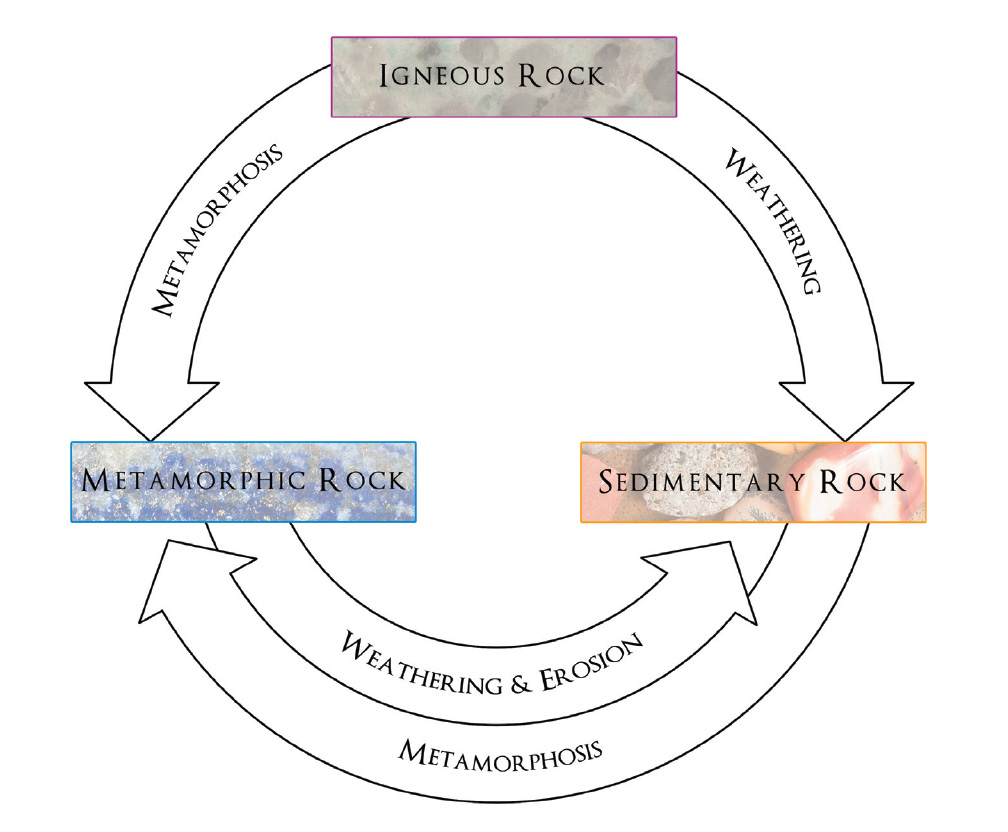
The rock cycle
THE MAIDEN: IGNEA
Ignea is the Maiden of Stone. She is the newborn rock that forms as lava and magma cool. She is the bright gem hidden in the womb of the Earth Mother, still waiting to be polished. Ignea represents all that the Maiden does, but her symbols arise from the start of the rock cycle, from igneous processes.
Deep in the belly of our planet, molten rock churns, eventually rising upward to find its way out. Sometimes this molten rock empties into pockets and seams in preexisting stone. There it cools slowly, enveloped by its matrix like a baby in utero; this process yields intrusive igneous rocks. Such rocks are referred to as plutonic rocks, a name derived from the underworld god of Greco-Roman religion, Pluto (Ploutōn) or Hades. Extrusive rocks, on the other hand, erupt from the earth, such as in volcanic events. Extrusive rocks are called vulcanites, borrowed from the same source as for the word volcano, the Roman god of fire and metallurgy, Vulcan. Extrusive rocks are born with all the pangs and pains of childbirth, and the youngest rocks you can find belong to this class.
Igneous rocks and their constituent minerals are grouped in the primary formation process. These rocks and minerals are the very first iterations of crystalline form to arise from the primordial chaos, the cauldron of liquid magma. Thus igneous rocks and primary minerals give rise to all other rocks, either by being weathered into sedimentary formations or transmuted by heat and pressure into metamorphic rocks. Metamorphic and sedimentary rocks are comprised of other rocks that have been transformed in some way, but igneous rocks alone are made fresh, born of liquid magma. They radiate vitality and represent the clean slate and pure potential of the archetypal Maiden.
Maiden of Fire
Ignea is embodied in igneous rocks and the minerals from which they are comprised. Her name derives from the Latin ignis, meaning “fire” as well as “luminary.” Ignea means “the fiery one” in Latin. Thus Ignea is the face of the Triple Goddess who is born of fire and stone; she is the luminous maid ready to embark on life’s journey.
Among the Celtic people, Brigid is perhaps the most beloved of fire goddesses. She is the solar maiden who was later syncretized with the pious virgin Saint Brigid, an early Irish Christian nun. To the Egyptians, the lion-headed goddess Sekhmet is associated with fire and is sometimes described as the daughter of the sun god Ra. Vedic literature records Agneyi, the fire maiden born to the god Agni.*8 The Romans had their Vestales, the maidenlike priestesses of Vesta who tended her eternal flame. So there clearly is a widespread connection between the element of fire and the archetype of the Maiden.
Ignea lives where fire and stone meet. Together these two elemental forces provide the means to create new rock, which in turn can be used to build new structures. Ignea provides not only the raw material but also the heat and light. Molten rock radiates a mesmerizing glow and intense heat. It can raze anything in its path on the surface of the earth and transmute surrounding bedrock when tracing its chthonic course through the crust. The Maiden archetype Ignea can thus ignite our own creativity and offer rapid transformation. She is fertility embodied, and her fiery glow is the light of passion itself. Like the raw element of fire, Ignea generates heat and illumination in our lives, helping to pave the way for new ideas to be born.
Manifest Potential
Igneous rocks begin as liquid rock cools. Compared to the innate order of crystalline solids, liquid materials display chaotic arrays of atoms and molecules. The composition of magma dictates which minerals will be formed as it cools, thus it is already encoded for the potential crystals that manifest from its liquid chaos. Other factors involved in the crystallization process include time, temperature, space, and pressure; these fine-tune how the minerals will ultimately form.
There are three primary igneous formation processes: liquid-magmatic, hydrothermal, and pneumatolytic.1 The liquid-magmatic process is simply the cooling of magma or lava, where seed crystals precipitate from the liquid as the temperature falls. This takes place at extreme temperatures, usually in the range of 700 to 1,100 degrees Celsius. Hydrothermal mineral formation occurs when the critical temperature of water (375 degrees Celsius and below) has been reached. Mineral solids are dissolved in superheated water, which can reach into cavities in the rock matrix. Crystals eventually precipitate from the aqueous solution, lining the rocks with crystalline druze. Pneumatolytic processes (from pneuma, meaning “breath” or “soul,” and lysein, “to dissolve”) involve gases and vapors escaping from molten rock and water; minerals dissolve from the surrounding rock and form new compounds with these gases, which are later deposited as new minerals.
No matter which specific mechanism is behind the growth of igneous rocks and primary minerals, the underlying theme is always the crystalline potential arising from the chaotic void of liquid or gas. Order is birthed from the fiery womb as Ignea enters the scene. The late Michael Gienger, one of Europe’s most respected experts on crystals and their uses, writes, “The first formation principle demonstrates a crystallization process based on the cooling and solidification of liquid magma. The mineral-forming elements contained in magma represent the potential and predisposition for formation, as they already determine what can be formed. The crystallization process itself, however, is determined by the factors of pressure, heat, space, and time, all of which decide in which manner the existing potential will be realized.”2 This statement reminds us that igneous rocks and minerals are the manifestation of pure potential. This is the very promise held by the Maiden; it is her springtide glory of flowers awaiting pollination. Janet and Stewart Farrar describe the archetypal Maiden as “the adventurous young flame that banishes indifference and leapfrogs obstacles, the lively curiosity that blows the dust off stale knowledge and gives it new perspectives.”3 Her potential is just coming to be realized, and she is willing to break free from the mold. Ignea, though crystalline, still retains the wildness of her liquid state. She is unfettered by social norms and therefore free to explore all avenues that excite her.
Ignea holds the promise of your inner potential, thus she can help us find ways to tease out hidden talents and secret yearnings. As the Maiden of Stone, she adds counterpoint to wanton caprice, for she is still grounded and stable. Her freedom to grow and change is shaped by circumstances, thus she helps us seek advantageous conditions for cultivating our own potential. Michael Gienger goes on to say of igneous rocks that “because of their similar manner of origin involved, [they] will encourage learning processes. Every magmatic mineral represents certain spiritual values and will support and encourage their development. In connection with this, the mineral will also encourage a certain kind of spiritual experience and corresponding thought and behaviour patterns, and may help with healing if these values, experiences, thought and behaviour patterns in any given case are conducive to overall good health.”4
The unearthing of buried talent is one of the gifts that Ignea and her totemic igneous rocks and primary minerals convey. The Maiden of Stone offers her fertile, volcanic ash and brilliant light to encourage higher learning and self-discipline. Working with her and her stones can encourage you to find order in chaos, to manifest your highest potential.
The Dual Nature of the Maiden
Igneous rocks are usually classified by their composition and texture, the latter of which reveals the environment in which they were formed. Aphanitic rocks are those with fine-grained textures. Their crystals are of diminutive size because they formed extrusively, such as from lava cooling from volcanic activity; this allows them to cool more quickly than intrusive rocks. Examples of extrusive igneous rocks include basalt, andesite, obsidian, pumice, and rhyolite. Phaneritic rocks, on the other hand, are coarse-grained rocks with visible crystal structures within their matrix. These rocks are formed by intrusive process, meaning they occur as magma cools slowly within the crust. Since these rocks form slowly over time, the minerals of which they are comprised have more time to form large crystals. Intrusive igneous rocks include granite, pegmatite, gabbro, anorthosite, and diorite.
Extrusive igneous rocks tend to relate to the bright, fertile aspect of the Maiden as embodied in the myth of Persephone. They are formed more or less above ground, and they have structures that support the movement and fine-tuning of subtle energy. The fine-grained crystals within these rocks promote movement, change, and fluency. Some extrusive rocks, like pumice and obsidian, lack crystalline structures altogether. These rocks often maintain a carefree fluidity that provides a sense of freedom and fulfillment to those who bear them.
Unlike their vulcanitic relatives, intrusive igneous rocks are formed within Earth’s crust and thus bear a deep connection to the darker aspects of the Maiden as Underworld Goddess. These rocks are the plutonites, so named for having been formed in the telluric terrain of the underworld. Like the pomegranate that Persephone ate that bound her to the realm of Hades, intrusive igneous rocks are the fruits of the underground, and they are deeply grounding and supportive. Intrusive rocks such as granite may even contain crystals of garnet, which bear a strong resemblance to pomegranate seeds.*9
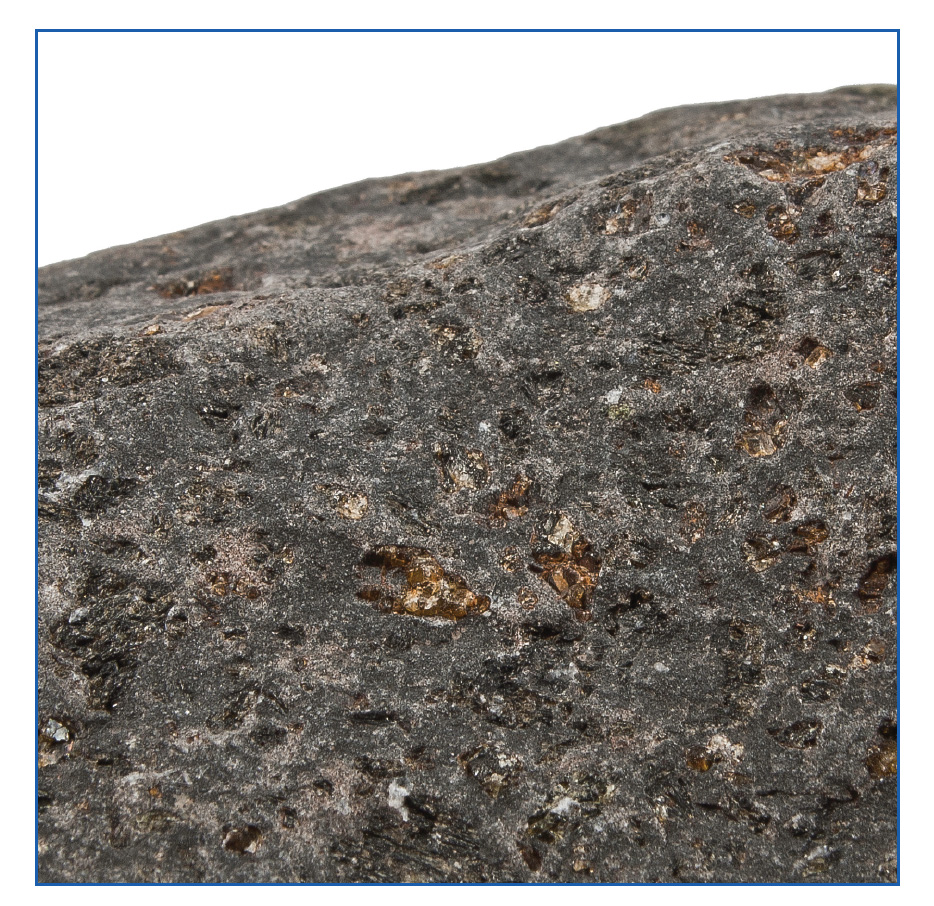
This example of basaltic porphyry is an extrusive igneous rock; note its fine-grained texture. The larger crystals in this rock are called phenocrysts, and they are typical of porphyry.
Intrusive igneous rocks and minerals provide a distinct connection to the introspective qualities that best serve self-development. These are the stones that are incubated within the womb of the Earth Mother, and they take their time forming larger crystals. Pegmatites, for example, are a class of granite that boasts the largest gem crystals among igneous rocks. Many precious and semiprecious gemstones are found within pegmatites, including amazonite, apatite, beryl (such as aquamarine and emerald), chrysoberyl, garnets, kunzite, topaz, most varieties of tourmaline, and zircon. The underlying symbolism is that within the depths of the psyche, hidden within our subconscious shadows, there are luminous gems waiting to be unearthed. By connecting to the underworld aspect of Ignea, we can follow her lead in journeying to these depths for our own healing and transformation.
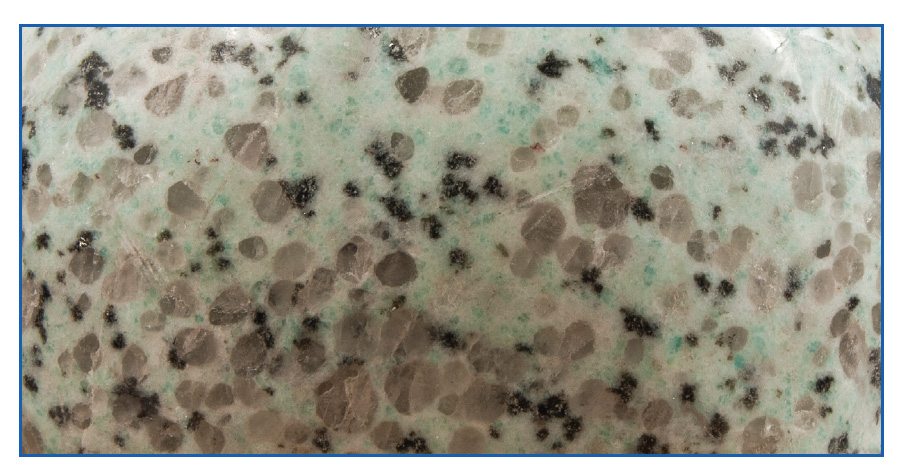
This polished granite is an example of intrusive igneous rock; note its large-grained texture.
Working with Ignea
Contact with Ignea can be used for sparking the creative process. She can help you receive inspiration, and especially in her extrusive aspect Ignea can invite movement and change. Igneous rocks are often formed by dramatic natural events, some of which can change entire landscapes in virtually an instant. Ignea holds this same potential. She is the one who can level your roadblocks and supply a more creative perspective, like volcanic ash making soil more fertile for new growth. Use any of Ignea’s rocks or minerals to connect to her energy for meditation, ritual, and spellcraft related to any of the following areas:
- Evocation
- New beginnings
- Spiritual cleansing
- Illumination
- Prosperity
- Love
- Learning and growth
- Creativity
- Fertility
- Removing obstacles
- Pyromancy
Igneous rocks and primary minerals are many and varied. Common igneous rocks include granite, rhyolite, andesite, basalt, anorthosite, peridotite, obsidian, gabbro, and diorite. The most frequent primary minerals include quartz, feldspar (including amazonite, moonstone, labradorite, etc.), muscovite and biotite mica, amphibole, pyroxene, and olivine. Other minerals that are usually formed by primary or igneous processes include danburite, rutile, apophyllite, hematite, most varieties of quartz (agate, chalcedony, amethyst, citrine, rose quartz, etc.), beryl (aquamarine, heliodor), several species of garnet, fluorite, pyrite, sodalite, and vesuvianite. Metallic ores found in igneous rocks are primary minerals such as gold, silver, and copper.
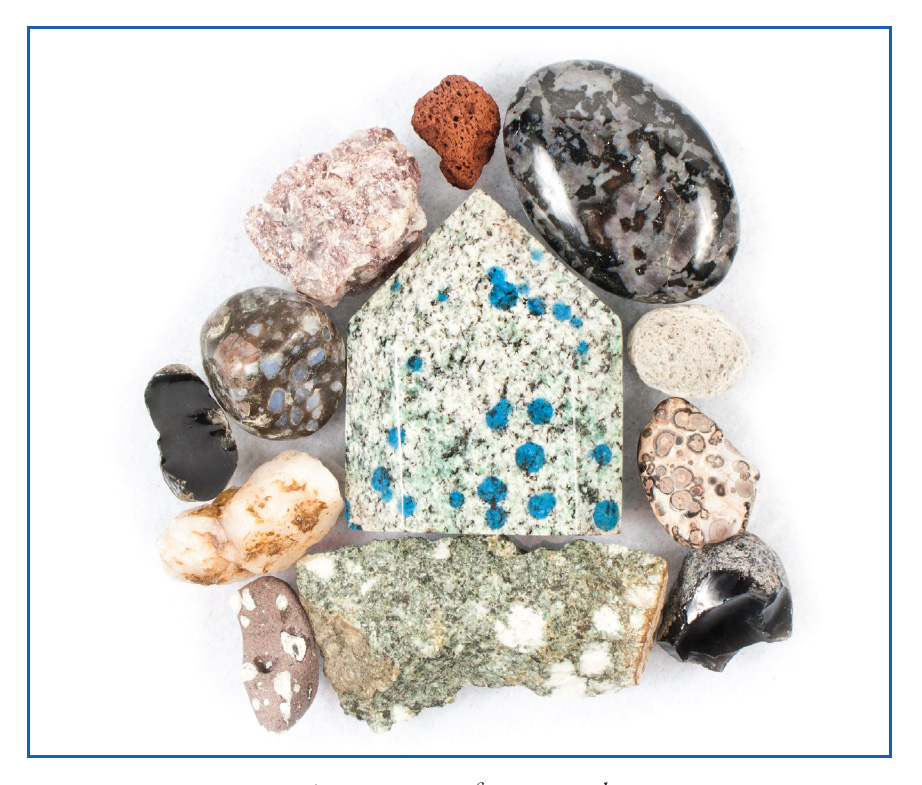
An assortment of igneous rocks
 Meeting Ignea
Meeting Ignea
Find a comfortable place to meditate. You may like to use igneous rock in this meditative journey, either holding it, placing it on your navel, or surrounding yourself with a ring of igneous rocks or primary minerals, preferably garnet or peridot. Light a candle, dim the lights, and close your eyes. Relax fully and deeply, and feel yourself becoming grounded and centered.
As you slip into the meditative state, an image of a rocky crevice sharpens in your field of vision. The cleft is big enough to crawl into, and you feel compelled to climb into it. Once inside, darkness obscures your vision; you are forced to feel your way as you descend into the earth. You pass roots and rocks and underground creatures, eventually reaching the point where heat and pressure mount. Soon the incline levels off and the opening widens to reveal a vast expanse of open space with a river of molten stone flowing through it. You have arrived at Ignea’s chamber.
Red-hot magma blazes, and its drifting light illuminates the silhouette of a young woman dancing on its surface. She is the Maiden of Stone. She is Ignea, the Bright One. Ignea’s playful, sultry groove is infectious—you can’t help but sway as you watch her. Ignea approaches. She takes your hand, and her eyes, bright as dazzling jewels, enchant you as you start dancing with her, uninhibited. Still dancing, you glide across the hidden chamber, following the stream of magma deeper into the earth.
Ignea’s dance slows to a halt, and she asks why you have come to her. You may reveal an area of your life that would benefit from her help, or you may simply tell her that you have come to build rapport with her. She listens intently, and her innocent heart opens to you as you speak. Ignea offers you whatever assistance she can, then she reveals a platter heavy with food and drink. Among the delights are garnet-red pomegranate arils. By accepting her offering you are bound to her in some way, making it easy for you to return to her inner-world chambers whenever you like.
After you have finished your meal, Ignea offers you an uncut gemstone—a ruby, sapphire, diamond, tourmaline, garnet, or aquamarine. It is a large, clear stone of igneous origin. Unable to refuse, you humbly receive her parting gift, offering your sincere gratitude. She bids you farewell, and you retreat, going back the way you came, falling to your hands and knees to climb back through the cleft in the rock and out to the world of everyday life.
Once you reach the outer world, this vision begins to fade. You feel your awareness returning to its normal state as you note your physical self and the room around you. Breathing deeply, consciously ground and center. Stretch or adjust your posture as needed and open your eyes. Record your experiences in your journal if desired.
Invocation to Ignea
..................................................
Hail Ignea!
Maiden of Stone, lava-born beauty
Share with me your underworld feast
Bless me with your freshness and your freedom.
Maid whose breath forms crystals
and whose molten path levels obstacles
Let your fiery ash nourish creativity.
May your bright jewels illumine my mind
and inspire me to new vistas.
THE MATRON: METAMATRIX
Regal and compassionate, the motherly face of the Triple Goddess of Stone is Metamatrix. She dwells where heat and pressure act on rock to direct its transformation. She births new stone; in her womb the alchemical processes of metamorphism work their magick. Metamatrix is the mountain-maker, the heavenly queen, and her chthonic womb incubates her underground treasures. Her name is taken from meta, meaning “beyond,” and matrix, “womb.” She is the mother who transforms all that she touches, taking old stone and granting it new life.
Metamorphosis occurs where heat and pressure transform preexisting rock. Metamatrix is the divine embodiment of this process. To better understand metamorphism, first let me paint a picture of the structure of our planet. The hard, rocky crust on which we live represents only a fraction of the depth of planet Earth. The seemingly solid rock on which we build our lives actually floats atop liquid magma that lies just below. That crust is comprised of multiple tectonic plates that shift from the convection-driven currents of magma below. Whenever tectonic plates meet or when magma intrudes into the bedrock of a tecton, the resulting heat and pressure causes the minerals in the old rocks to rearrange themselves into new, more stable forms. This is metamorphism at work.
Though there are several different processes of metamorphism, the basic theme is always the same. The key words pertaining to metamorphic rock, and therefore to Metamatrix herself, are transformation, change, and alchemy. As an aspect of the Great Mother, Metamatrix overflows with the currents of life and change. To live is to change, and she oversees all acts of transformation.
Queen of Earth and Heaven
Metamorphic rocks are born through two basic processes: contact metamorphism and regional metamorphism. The former takes place exclusively within the depths of the crust, while the latter is created by the movement of tectonic plates. These two main processes of metamorphism relate to the dual nature of the Great Mother as both Earth Mother and Queen of Heaven.
Contact metamorphism takes place where igneous rock is formed intrusively. It is a relatively low-pressure environment with high heat. As we learned from the previous account of Ignea’s birth, magma pools within plutons to cool slowly over time. Because this fresh igneous rock is insulated by older rock, it can take thousands of years to cool. The heat from the molten rock affects the solid rock that it makes contact with, and the host rock, or matrix, is transformed. The nearer to the source of heat, the greater the transformation will be. The metamorphic rock that results is like a womb enveloping the younger igneous rock as it cools.
The symbolism of this process is overtly motherly. The seeds of new crystals grow within the matrix, a word that translates as “womb” in Latin. As these crystals precipitate from the molten solution, new rock is slowly formed. The process of birthing new stone utterly transforms the parent rock. Even terms used by geologists like matrix and parent rock imply a motherly relationship between the old and the new rock. It seems that Metamatrix has been lurking in the subconscious minds of geologists for centuries.
Contact metamorphism is also deeply connected to the Great Mother in her darker aspects. Such stones embody her telluric transformation, and they become the matrix, the womb of the newborn igneous rock. Because they are formed within the darkness of the interior landscape of Earth, such rocks (and their constituent minerals), hold the keys to inner world journeying, and they may help us confront our shadow side, those aspects of the self that are hidden in the subconscious mind or denied altogether.
Metamatrix, in her underworld shroud, is the stone from which Hades’s home is built. Metamatrix is the one who births us and the one who receives us in death. The Dark Mother archetype resides in Metamatrix, for the great stone tombs of the world are human renderings of her chthonic womb. Her stony kingdom is the dwelling place of dragons and monsters, and ley lines, or dragon lines, crisscross her body.
The second type of metamorphism is called regional metamorphism. It occurs when tectonic plates converge, especially during the process called orogeny, a term derived from the Greek word meaning “mountain birth.” These rocks experience high pressure and lower heat. The constituent minerals in metamorphic rocks rearrange themselves such that they can withstand the increased pressure. Their crystals move to be perpendicular to the direction of the force, often exchanging elements with neighboring minerals to create new compounds that are better suited to survive the forces at play in metamorphism. Such rocks are often foliated, meaning banded, and the bands of different minerals may twist and bend as the tectonic plates continue to shift.
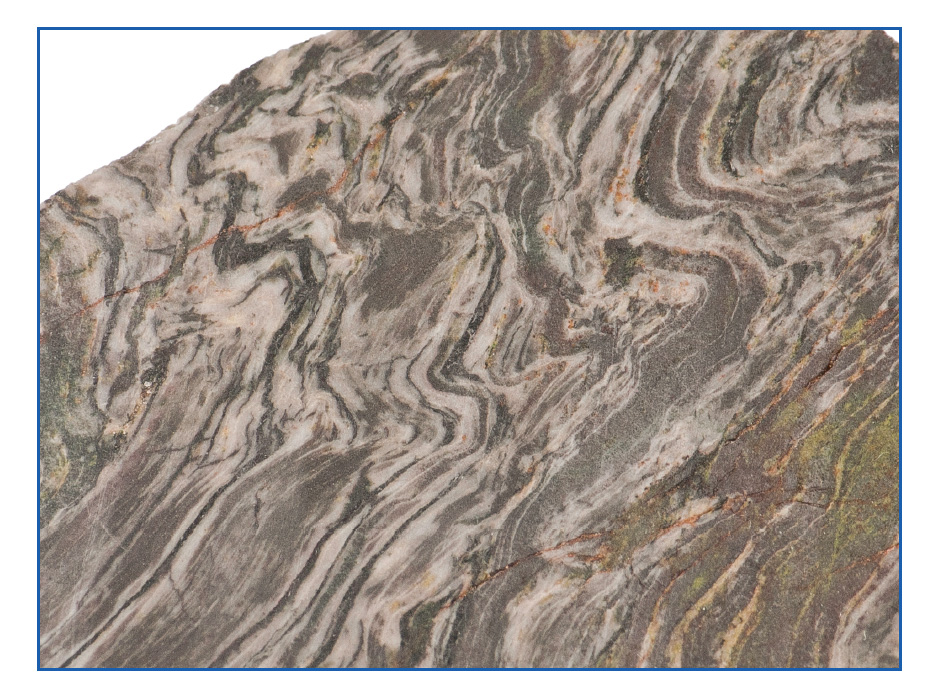
Metamorphic rocks such as the one pictured here often exhibit swirling layers called bends and folds.
Orogeny gives rise to mountains as tectonic plates crash into one another, lifting masses of rock high into the sky. For this reason, rocks created by regional metamorphism tap into the ouranic aspect of the Mother Goddess, i.e., the Queen of Heaven. Even the words orogeny and ouranic are related etymologically; both ultimately come from a root that means “elevated” or “heavenly.” Mountains are the meeting place of heaven and earth, thus they are sacred to the deities of storm, sky, and earth. Rocks and minerals that are found in mountain ranges, especially those of metamorphic origin, are consequently the preeminent stones for communing with the celestial aspect of Metamatrix. Just as in her telluric aspect she is the womb in which igneous rocks are born, this aspect of the Great Mother births mountain ranges, which ascend toward her heavenly throne. Lapis lazuli is such a metamorphic rock; it’s no wonder this gemstone, which resembles the sky, has been associated with the Queen of Heaven across cultures and times.
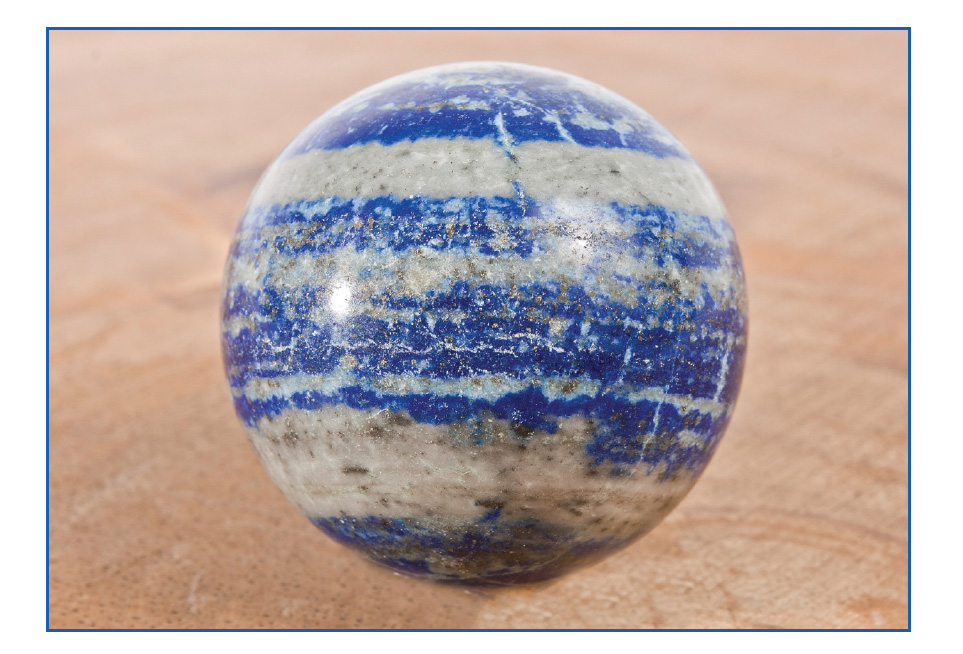
Lapis lazuli is a metamorphic rock. Note the distinct bands, or folia, of blue lazurite, golden pyrite, and white calcite.
The Great Rite
One of the traits that marks a woman’s passage from maidenhood to the status of mother is ownership of the creative power of the Great Goddess. In a visceral sense this means the ownership of female sexuality and the reproductive cycle, though in the bigger picture it includes all acts of love, pleasure, creation, and transformation. Metamatrix oversees this creative impulse through her geological symbolism.
Motherhood follows the creative reproductive act. Though the earliest humans may not have initially recognized the precise relationship between sex and childbirth, it surely didn’t take long to observe their causal relationship. The most ancient and primal alchemy takes place with the union of opposite forces, such as when male and female come together to create new life. At this moment, the Maiden becomes the Mother; her belly grows heavy as she transforms the seed of her consort into the divine child. In witchcraft and other magickal traditions, this holy union is depicted in ritual form in the Great Rite. Typically, this ritual is performed symbolically when the blade (representing the male) is placed in the chalice (female), though it also features the private sexual union between the high priest and the high priestess.*10
In the rock cycle we see Metamatrix engaged in the Great Rite too. She is impregnated as a result of the intimate dance of converging tectonic plates and the flowing seed of molten rock. In this symbolic union, the forces of the skyward-reaching masculine and the underworld feminine collide in an act of regional metamorphism, and the fiery male principle seeds the earthy womb of the Goddess in contact metamorphism. In either case, the rock is transformed in the same manner that the Maiden becomes the Mother.
Metamatrix is the high priestess of the mineral kingdom, for she is the one who oversees the magick of earthly transformation. In Latin, the word for “metamorphose” is mutare. Mutare is an anagram of our word mature—in this case, the Mother must reach maturity to transmute the seed to create new life. Because she has crossed this threshold and become familiar with the acts of transfiguration, Metamatrix rules over all acts of magick and alchemy.
Personal Alchemy
In spiritual practice, the acts of transmutation and metamorphosis are part of the process of alchemy. Since Metamatrix is the divine personification of metamorphic rocks and tertiary minerals, she is naturally the chief alchemist of the mineral kingdom, conducting the Great Work of the alchemical arts through her transfiguration of rock. Her metamorphic realm is symbolically comprised of the lapis philosophorum, the philosopher’s stone sought by classical alchemists that transforms base metals into gold and produces the elixir of life for achieving immortality.
As a Mother archetype, Metamatrix seeks to guide and nourish her children physically, psychologically, and spiritually. She herself has been made stronger by her own transformation such that she can lead us through our metamorphoses. Though metamorphic rock is formed dramatically—by extremes in heat and pressure as mountains rise skyward and magma flows underground—personal alchemy often takes place within the internal landscape of our hearts and minds. Our own transformations require honest self-reflection and a willingness to grow, and Metamatrix provides the security and reassurance that we can make it through times of transition with ease.
Metamorphic rocks and the tertiary minerals comprising them initiate the internal processes necessary for positive change to take place. They can jump-start our sense of awareness and offer the courage necessary to take the first steps toward transformation. In this sense, personal alchemy is not aimed at unimaginable wealth or eternal life; instead, it is the realization that our leaden consciousness can be sloughed off, like a snake shedding its skin, to reveal the golden light of the soul. Typically, we experience the need for this only when the pressures of life become unbearable, as if the weight of mountains were bearing down on us. Metamatrix and her totemic rocks and minerals offer themselves at moments such as these to help us rise to the occasion. In The Eight Crystal Alliances, the authors, a group of therapists known as the Group of 5, state, “Since metamorphic stones have been transformed by pressure and heat, they have the potential to rescue us and guide us toward a sometimes radical change. They can help unveil certain facets of our being that remain hidden from us and from others. We will emerge from this process transformed. The pressure and heat that have tested metamorphic rocks symbolize an unease within us that can often persist for years or even entire lifetimes.”5
It is this very process that we experience in life that often initiates the transmutation. Metamorphic rocks have themselves been transformed by extreme situations, and they can help us harness the challenges we experience in everyday life in order to change for the better. Most importantly, they do this by helping us comprehend what internal and external changes are most needed to grow and thrive. Michael Gienger writes of this, saying, “Metamorphic rocks and tertiary minerals stimulate this inner transformation process. They encourage critical self-reflection and help us to realise and understand those things in our lives that are not durable and what needs ending because it makes us feel dissatisfied. These minerals and rocks bring radical changes that lead to a more fulfilled, purposeful life.”6
Metamatrix mothers us through the alchemical operation. At times she offers comfort; sometimes she nudges us toward our next step. No matter the counsel she gives, Metamatrix invites us to find greater strength under pressure. When we turn to her, she envelops us in her telluric womb, the very vessel in which matter and consciousness are transmuted.
Working with Metamatrix
In a practical sense, Metamatrix is the patron deity of the magickal arts. All acts of magick are transformative processes, the domain of this Goddess of Stone. She is the initiatrix, the alchemist, and the protectress of witches and magick-makers. Metamorphic rock and tertiary minerals can be used to invoke her power whenever needed.
Connect to Metamatrix for assistance with any of the following:
- Change
- Protection
- Strength and courage
- Healing, especially emotional
- Sex magick
- Love
- Introspection and clarity
Common metamorphic rocks include marble, quartzite, gneiss, schist, slate, anthracite, soapstone, and serpentinite (a serpentinerich metamorphic rock). Minerals birthed during the Tertiary period (about 65 million to 2.58 million years ago) and formed by metamorphic processes include kyanite, staurolite, andalusite, some forms of garnet and mica, emerald, corundum (ruby and sapphire), jade (both nephrite and jadeite), rhodonite, serpentine, zoisite, and others. Minerals like quartz, calcite, amphibole, and feldspars, among others, are frequently found in metamorphic rock. Tektites such as moldavite and indochinite (the common black variety) are considered metamorphic rocks as well.
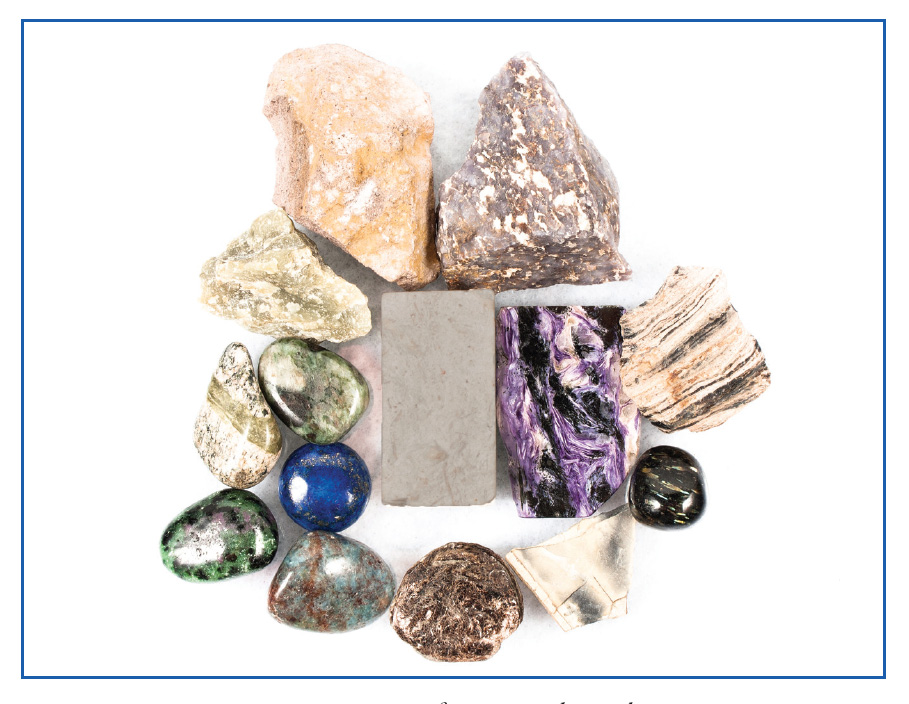
An assortment of metamorphic rocks
 Journey with Metamatrix
Journey with Metamatrix
Make yourself comfortable. You may like to use metamorphic rock in this meditative journey, either holding it, placing it on your heart, or surrounding yourself with a ring of metamorphic rocks and minerals. Light a candle, dim the lights, and close your eyes. Relax fully and deeply, and feel yourself becoming grounded and centered.
With eyes closed, visualize yourself following a wide footpath through mountainous terrain. The trail rises and falls as it winds between rocks and cliffs. You can see the bends and folds in the rock itself—the evidence of tectonic plates moving and colliding over eons. Many of the stones are peppered with glints of mica. You follow the path as it narrows. Turning sideways to ease your body between two boulders, you find yourself in a secluded space, a hallowed clearing amid giant stones. A mountain peak looms high above you.
In the stillness, you begin to feel a faint tremor in the ground beneath you. Looking around to find the source of the movement, you notice that across the spot where you sit encircled by boulders there is a gap between the boulders that beckons to you. Moving through that portal you find that you have entered a twisting labyrinth bordered by fallen rocks. The path itself bends back and forth and winds around itself like the swirling patterns of metamorphic rock, as if it were the processional entryway to an ancient temple. As you reach the end of the winding path, you arrive at a doorway carved into the mountainside that leads into the inner sanctum of this temple of stone.
With head bowed reverently, you step into the heart of the mountain, and sitting on a throne glittering with gemstones is Metamatrix, the Mother of Stone. She is adorned in fineries befitting the queen of the mountaintop and high priestess of the mineral kingdom. She waves you forward, and you kneel before her majesty. Metamatrix rises and invites you closer. She takes your hand and leads you into the inner sanctum of her holy space.
Inside her sanctuary, Metamatrix stands before an altar hewn from the rock wall of the room itself. On it are her ritual tools: wand, knife, dish, and cup. In the center of the room there is a mighty stone cauldron that casts an eerie glow around these strange environs. Metamatrix leads you to it, and you see magma swirling within this vessel. She bids you to prepare yourself for transformation. You cast off your clothes and allow your worries and fears to fall to the floor with them. Metamatrix offers a hand to help you climb up onto the lip of the cauldron. You take a deep breath, close your eyes, and drop down into the glowing liquid stone.
Inside the cauldron you feel no discomfort, only a gentle warmth. Your body becomes hardened in the pool of magma; your mind and spirit are transformed along with it. You find that you can breathe effortlessly too. Spend as much time in the cauldron as you like, and then, when you’re ready to climb out, Metamatrix hoists you from the vessel. She dries you and offers you a new set of vestments to don. You have been transformed by your dip in her cauldron of metamorphic rock.
You may spend time with the Mother, perhaps asking her for help or guidance. When your time together comes to an end, Metamatrix pulls a talisman from her altar and fastens it around your neck. You feel its comfortable weight against your chest and thank her for her gift. Metamatrix bids you farewell as you leave her mountain home by way of the path that brought you to her. Before long you are back where you started.
Begin to draw your awareness back into your body. Ground and center yourself, and shift your focus to the room around you. Begin to move or sigh or stretch as you wish, until you feel as though you are firmly back in your body, in the here and now. Open your eyes and reflect on your journey with Metamatrix. Record it in your journal if desired.
Invocation to Metamatrix
..............................................................
Hail Metamatrix, whose womb incubates new rock!
Hail Metamatrix, mother of mountains!
Heavenly queen of earth and sky
I raise my heart to thee
that it may be transformed by your touch.
Grace me with your mysteries of transformation
Show me how to use the pressures of life
to reinvent myself
and guide me now and always.
THE CRONE: SEDIMENS
With her wizened face, like weathered rock exposed to the elements, Sedimens is the final aspect of the Triple Goddess of Stone. Her domain is that of sand and silt, fossils and timelines; she is a record written in stone. Sedimens is cloaked in the strata of deep canyons. Her stones are those beaten down and rebuilt by the passing of time.
Sedimentary rock symbolizes time itself, and in its layers is the record of the ages of planet Earth. This phase of the rock cycle represents the Crone, as she too is the one who holds memories of the past. The Crone is the wisdom-keeper and the bearer of traditions; she is the living embodiment of time, the recorder of time who passes her memories on to the next generation. Sedimens’s body has been collected from the grains and fragments of other rocks of all three phases (igneous, metamorphic, and sedimentary). She knows the mysteries of death and rebirth, for her rock and mineral allies are born again and again.
Sedimentary rocks and the secondary minerals formed by sedimentary action are grouped in two distinct categories: detrital and chemical.*11 The former consists of those rocks that are broken down and re-formed by mechanical means, meaning the action of sun, wind, water, and ice, which gnaw the exposed surfaces of stone. The resulting fragments are carried away, broken down further, and lithified—turned back into stone. Chemical sedimentary rocks, on the other hand, are dissolved by the elements and later precipitate out of solution. Due to the erosive qualities of wind and rain, sedimentary stones correspond to the dual elements of air and water.
The Subconscious Realm
Sedimentary rocks, more so than any other variety, are the result of environmental forces; they are at the mercy of the natural world and its elements. Heat from the sun, overnight freezes, falling rain, flowing streams, and howling winds that sandblast exposed rock with the sediments they carry will eventually wear away entire mountains. Rocks are not only broken down by the environment; the fragments they eventually become are then carried great distances by the same forces. Eventually these particles are deposited in a new location through the process of sedimentation. They then lithify by means of compaction or cementation, or both. Thus, new rock is recycled from old.
Our very identity is formed in a similar process. We too are a product of our environment. We are shaped by the beliefs and behaviors of our family, teachers, and friends. The habits we learn early in life often crystallize into the patterns that form our subconscious beliefs. We are clearly molded by our past; the choices we make are colored by previous experiences, good or bad, and therefore we continue to play out our patterns time and time again. With each new experience, we build new memories; these usually reinforce the habits, goals, dreams, and beliefs that have aggregated in our subconscious—just like sediment accreting into stone. Because of this similarity, sedimentary rocks and their constituent secondary minerals are helpful tools for recognizing the subconscious programming we carry.
In traditional Chinese medicine, sedimentary rock is associated with wei qi, the essence that functions at the instinctual level of your being.7 Your instincts respond to external stimuli much the same way sedimentary processes like erosion and compaction are a response to environmental factors; in this way stones that are formed by sedimentary action reveal how the internal landscape of your mind responds to external situations.
Invoking Sedimens and working with her sedimentary rocks and minerals can shed light on the unconscious patterns in your life. Because of the causal relationship between your subconscious and your environment, you can leverage the insight gleaned from these rocks and minerals to create positive change through adaptation. These rocks, say the Group of 5, “enhance our understanding of the events that have shaped and molded our lives, forging the being we have become today. They can help us transform our vision of life and of ourselves so that we can continually adapt to our environment.”8
Keeper of Time
Like sand collecting at the bottom of an hourglass, the formation of sedimentary rock records the passing of time. Sedimens is the memory-keeper and storyteller of the three faces of the Goddess. As the eldest, she has the longest memory; it stretches far back to the beginning of time itself. Her name is a portmanteau of two Latin words, sedimentum and mens, meaning “sediment” and “mind.” She is the one whose mind holds the collective memory of our planet, both geological and biological.
Sedimentary rock is a storied stone, often wearing many colors, each one a memory of a different age. Geologists use the strata in this rock to date events in the geological record. We too sort through the layers of our memory to locate hidden memories and old wounds, the buried or repressed events of the past that continue to affect our daily life. The elemental energies of the forces that weather sedimentary rock resonate with the mind: air with the conscious, water with the subconscious. Sedimens can expose the connections between the two so that we can integrate the lessons that dwell there for deep healing.
In particular, fossils are sacred to Sedimens. Fossils are the remains of once-living organisms that have been preserved in stone. They may be impressions left by organisms, such as footprints or casts of tree limbs, or they may be the mineralized tissues of living beings. Fossils have a strong link to memory, karma, and fate—all the domain of the Crone. In Crystals for Karmic Healing, I describe the effects of fossils:
As sedimentary stones, fossils help to sift through the debris and baggage that we carry. This makes them helpful for resolving karma, especially that which is stored in the causal body [the layer of the aura that records karmic memories]. The causal body is composed of bands and layers reminiscent of sedimentary rock, thus making fossils attuned to sorting through and stabilizing the information of the causal body. Fossils are traditionally connected to the past, since they are the product of the passage of time. They serve to provide a window into other eras, such as by connecting to ancestral energy or for undertaking past-life journeys.9
Sedimentary rock, whether fossiliferous or not, carries the memories of our world. It records the passage of time. Comprised of bits of the past that are cemented together, sedimentary rock symbolizes the way that myth, history, and memory are woven together as part of the fabric of time. Sedimentary rock is the storyteller of the rock tribe, the weaver and poet. Like the three Fates of Greco-Roman mythology who spin, measure, and cut the thread that determines the story of our life, Sedimens deposits sediment layer by layer, to grow her stones that tell the story of our planet.
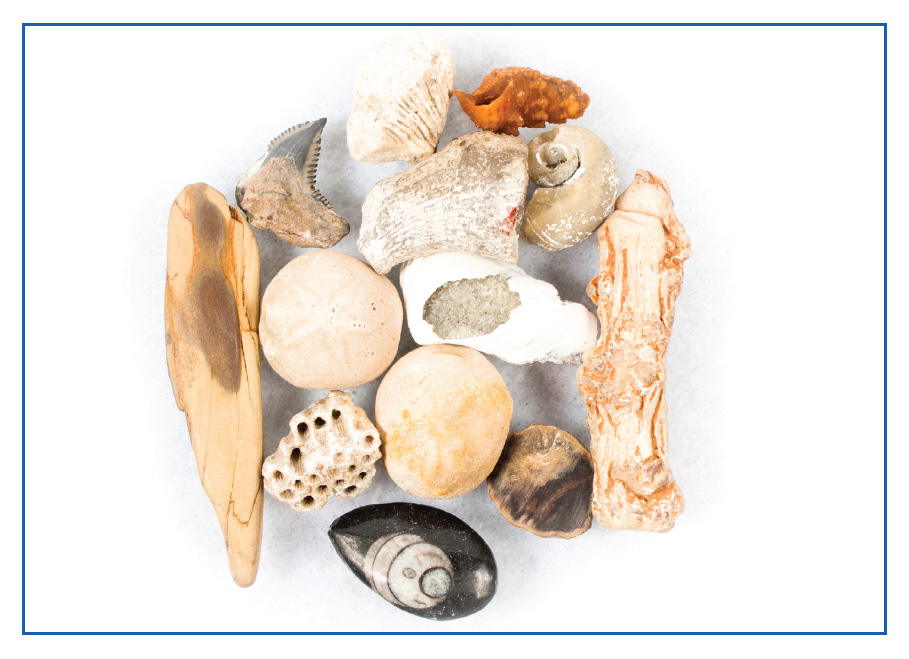
Fossils are sacred to Sedimens.
Alpha and Omega
Traditional myths associate Crone figures with death and decay. Sedimens follows in this tradition, as she oversees the forces that grind mountains and dissolve bedrock. The Crone is the face of the Triple Goddess who has known the greatest loss; as the elder, she has buried kin and clan, friend and foe. She is midwife, nurse, and undertaker in one. Her role is to be the intermediary between life and death. Sedimens is thus the psychopomp of the mineral kingdom. A psychopomp guides the souls of the dead from this world to the next. Sedimens guides the remains of old rock—now reduced to dust—to its next incarnation. She is the gatekeeper between the world of the living and the realm of the dead. Her weathered face has witnessed endless deaths, but it has also brought new life into the world. The Crone aspect of the Triple Goddess is alpha and omega incarnate; she is the walker between the worlds, straddling the land of the living and that of the dead.
Sedimentary rock forms as old rock symbolically dies and is reborn in a new form. Unlike metamorphic rocks, which are transformed in situ and made of the same components as their parent rock, sedimentary rocks are broken apart and carried away. Their constituent minerals intermingle, much the way our souls do on the other side of the veil between the worlds. Sedimentary rocks are not classified by discrete composition and formation process alone; they are defined by the journey they take, which sorts and shapes the particles from which they are made. In the same fashion, our soul learns its lessons through multiple Earth journeys.
Sedimens is the shaman of the geological kingdom. She travels between life and death, silt and stone, to guide rock through its stages of death and rebirth. She can work to assist us in crossing our own alpha-omega thresholds. Sedimens extends her hand to support us in endings and beginnings. She offers comfort to those grieving the dead, and she joyously celebrates the arrival of new life. Sedimens, the Crone of the Goddess of Stone, is near at hand any time we cross the liminal zones, whether through the stages of life or in ritual and meditation; connect to her for help whenever you need it.
Working with Sedimens
As a partner in your work, Sedimens offers her expertise in times of transition. As the storyteller and wisdom-keeper, the Crone is a teacher and tutor; she can assist in acquiring and assimilating intellectual and spiritual lessons. Sedimens offers deep healing from old wounds, and she helps you find your ancestral roots, whether those of your genetic family or your spiritual family. Since her stones are formed by others breaking apart, Sedimens is an expert at banishing, breaking bonds, and cutting energetic ties between people. She can be invoked in rites of protection too. From her connection to the cause-and-effect nature of time and destiny, Sedimens rules divination and prophecy. Connect to Sedimens through sedimentary rock and secondary minerals for workings related to
- Shamanic journeys
- Spirit contact
- Divination
- Healing, especially on the karmic level
- Connecting to the ancestral realm
- Banishing, binding, and uncrossing
- Protection
- Learning
- Rites of passage
- Birth and death
- Regeneration
Working with sedimentary rocks and minerals aids in connecting with the Crone of the Triple Goddess of Stone. Some common detrital sedimentary rocks include sandstone, mudrock, conglomerates, and breccia. Those that form as a result of chemical weathering include chalk, chert, flint, limestone, shale, travertine, and dolostone. Speleothems (cave formations like stalactites, stalagmites, etc.) are also sedimentary in nature. Minerals that are frequently formed by secondary processes include calcite, aragonite, dolomite, halite (salt), gypsum (selenite), pyrite, apatite, aventurine, cerussite, celestite, vivianite, azurite, malachite, howlite, turquoise, and opal. Fossils are naturally the domain of Sedimens too.
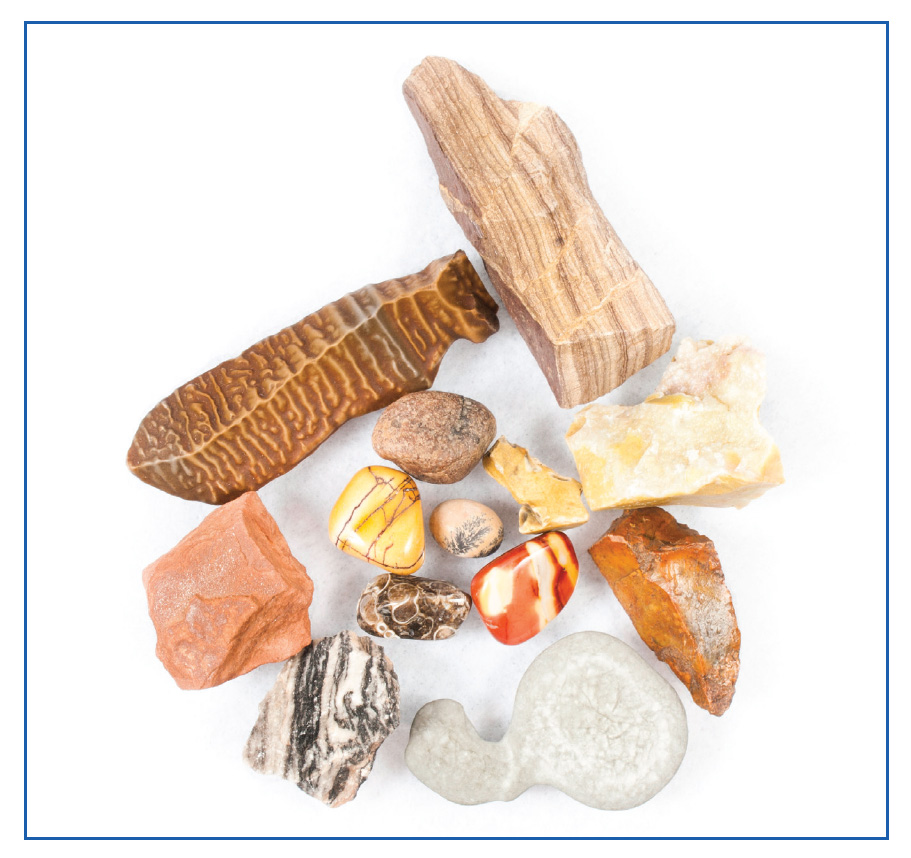
An assortment of sedimentary rocks
 Journey with Sedimens
Journey with Sedimens
Make yourself comfortable. You may wish to use sedimentary rock in this meditative journey, by either holding it, placing it on your brow, or surrounding yourself with a ring of sedimentary stones. Light a candle, dim the lights, and close your eyes. Relax fully and deeply, and feel yourself becoming grounded and centered.
In your mind’s eye, visualize yourself walking on a sandy path leading toward a canyon. As you reach the edge of a divide in the earth, you see an ancient stairway that has been cut into the side of the cliff face. Cautiously, you take your first steps down toward the bottom of the gorge. As you descend, take note of the layer upon layer of rock, each layer a different hue.
When you reach the bottom, there is a hollow cave etched into the stone. Follow it inside. Firelight from deep within seems to beckon you. The warm glow reflects off stalactites and stalagmites; crystals of calcite glitter from alcoves in the cave, and shadows dance all around you. A shrouded figure takes form in the distance—Sedimens awaits you.
When you reach her, you find that she is wrapped in a stony cloak; it is patterned with strata, like the layers of sediment in the Grand Canyon. She bids you to come toward her and greets you aloofly. Inspecting her, you get lost in her wild tangle of hair and the crisscross of wrinkles etched on her face. Her gnarled hands hold a pouch of sacred stones; she will cast the stones to divine the answer to any question you may have. If you have a particular question, ask it now.
Sedimens casts stones on a circle drawn on the cave floor on which arcane figures are traced in chalk. Stones of different colors, shapes, sizes, and textures tumble onto the ground. Sedimens stoops low to see them and lets out a knowing grunt. Her raspy voice offers an interpretation of their pattern. Listen to her guidance and thank her. You may ask more questions of her lot of stones, or you may simply listen to her stories, her memories and myths.
When your visit draws to a close, Sedimens opens her arms to embrace you. Though she appears fierce and terrible, she softens at this moment to reveal her tender, grandmotherly side. You know that you are welcome to visit her whenever the need arises. Before you turn to leave, Sedimens reaches into her robes to draw out a stone—a precious gift for you. You bow your head in gratitude and proceed toward the mouth of the cave.
As you step into the canyon, you find that the sun has set, and you have only starlight to guide you. Ascending the steps, you notice how the strata in the rock faces have taken on new colors. Finally, you reach the top of the stone staircase and step back on the path that led you here.
Begin to feel your awareness returning to your body. Listen to the sounds of the room; stretch, sigh, or wiggle in any way that helps you return more fully to the present moment. When you feel fully aware, open your eyes. Reflect on what Sedimens has revealed to you; add it to your journal if you feel compelled to do so.
Invocation to Sedimens
...........................................................
Sedimens, craggy Crone of stone,
She who is weathered and resurrected,
I call thee.
O keeper of time and ancestral wisdom,
weave the web of erosion and crystallization
and open the gates between life and death
that I may better know thee.
FINDING YOUR OWN CONNECTION
Since the combinations of rocks and minerals on our planet are practically innumerable, there will never be a clear-cut delineation of the archetypal faces of the Triple Goddess. Some aspects of the phases of the rock cycle may overlap with more than one face of the Triple Goddess. For example, igneous rocks—and the processes that form them—are attributed to the Maiden. A volcanic eruption, though it creates new rock, does wreak havoc on the countryside, destroying everything in its wake. This could be seen as an aspect of the Crone, who straddles the world of the living and the world of the dead; by bringing destruction, she prepares the way for new life, as the volcanic ash is rich and fertile.
In a similar fashion, you will find rocks and minerals in your toolbox that do not neatly fit into just one of the three aspects of the Triple Goddess. In those instances you can meditate with the stone (or stones) in question and find out just how it relates to the Triple Goddess. One of the fundamental mysteries of the Triple Goddess is that she is three-in-one and one-in-three at once; thus, reaching only one of her aspects opens the door to contacting all three facets. This is rather like a hologram, wherein any fragment of a holographic image can produce the entire image. So it is with the Triple Goddess.
To really enrich your practice with stones, pay heed to how they are formed. Look for correlations between formation processes and the Triple Goddess. Use them as tokens for reaching out to Ignea, Metamatrix, and Sedimens in meditation and ritual. Most importantly, visit these goddesses in your work often, in meditation or via shamanic journeying. With each visit you can explore a different aspect. Meet Ignea’s extrusive counterpart after seeing her underworld intrusive visage as described in the meditation in this chapter. Likewise, look for the telluric, dark aspect of Metamatrix or the fearsome face of Sedimens. Because they have no ancient lineage of worship, we have an opportunity to get to know them through our own ecstatic states of personal gnosis.
One of the most powerful ways to work with the Triple Goddess is to select three stones, one representing each formation process, and place them in a triangle around you. Sit within this simple stone circle to meditate, or make it large enough to conduct a ritual within its confines. Small stones may be used to lay out a plain crystal grid on your altar, perhaps encircling a candle. I suggest you try this with the consecrated talismans of Ignea, Metamatrix, and Sedimens as a means of drawing on the power of these goddesses, thereby recharging the stone talismans and enhancing your magickal workings.
However you choose to work with the Triple Goddess of Stone, know that respect, humility, and an open mind will go a long way toward furthering your understanding. Invite these archetypes to meet you in your dreamtime journeys and invoke their aid in spells and rituals. In time, you will come to know them and their respective rocks and minerals in a new light.